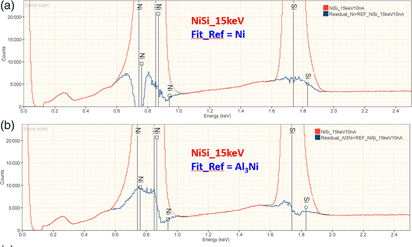No CrossRef data available.
Article contents
Quantitative Electron-Excited X-ray Microanalysis With Low-Energy L-shell X-ray Peaks Measured With Energy-Dispersive Spectrometry
Published online by Cambridge University Press: 03 September 2021
Abstract

Quantification of electron-exited X-ray spectra following the standards-based “k-ratio” (unknown/standard intensity) protocol with corrections for “matrix effects” (electron energy loss and backscattering, X-ray absorption, and secondary X-ray fluorescence) is a well-established method with a record of rigorous testing and extensive experience. Two recent studies by Gopon et al. working in the Fe–Si system and Llovet et al. working in the Ni–Si system have renewed interest in studying the accuracy of measurements made using L-shell X-ray peaks. Both have reported unexpectedly large deviations in analytical accuracy when analyzing intermetallic compounds when using the low photon energy Fe or Ni L-shell X-ray peaks with pure element standards and wavelength-dispersive X-ray spectrometry. This study confirms those observations on the Ni-based intermetallic compounds using energy-dispersive X-ray spectrometry and extends the study of analysis with low photon energy L-shell peaks to a wide range of elements, Ti to Se. Within this range of elements, anomalies in analytical accuracy have been found for Fe, Co, and Ge in addition to Ni. For these elements, the use of compound standards instead of pure elements usually resulted in significantly improved analytical accuracy. However, compound standards do not always provide satisfactory accuracy as is demonstrated for L-shell peak analysis in the Fe–S system: FeS and FeS2 unexpectedly do not provide good accuracy when used as mutual standards.
Keywords
- Type
- Software and Instrumentation
- Information
- Copyright
- Copyright © The Author(s), 2021. Published by Cambridge University Press on behalf of the Microscopy Society of America



